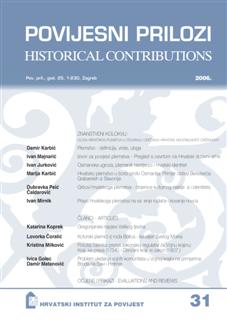Osmanska ugroza, plemeniti raseljenici i hrvatski identitet
The Ottoman Threat, Noble Displacees, and Croatian Identity
Author(s): Ivan JurkovićSubject(s): History
Published by: Hrvatski institut za povijest
Keywords: Ottoman threat; the Late Medieval and Early Modern period; involuntary(forced; impelled) displacees; nobility; croatian identity.
Summary/Abstract: The processes of internal and external migrations of the population of medieval croatian lands (croatia, Slavonia, Dalmatia), initiated in the first place by the Ottoman military advance (but also by climatic changes, more and more frequent years of famine and plague epidemics) during the period from the fall of Bosnia (1463) to the Battle of Sisak (1593), resulted with the loss of more than 60 percent of native population. Such prolonged state, besides the demographic catastrophe, caused also changes of political, economic, social, religious and cultural patterns and relations among people in these areas, in which the nobility played leading military and political role throughout all that period. Although the most part of the nobility itself suffered the fate of displacees, the noblemen thanks to persistent attempts of survival in the inherited area were solving both the issue of their own existence and that of stopping the Ottoman advance towards central and Western Europe. At the very beginning of the existence in the new surroundings the displaced croatian noblemen faced basic problem: insuring sustenance for normal life of them and their families. In order to achieve that primary goal, that is also the keeping of standard of living and preservation of the standard of living they were used to until their displacement, a nobleman had to use different strategies of survival and ways of integration into new surroundings. Their aim was, thus, of conservative nature–– preservation of social position and respect enjoyed by the family. Strategies used for achieving that conservative goal were for the most part inherited from the pre-Ottoman period, but there were also some new ones. In the era of mass appearance of noble displacees such a goal was hard to achieve and such families used traditional strategies for acquiring new estates––in the first place by the strategy of entering military contingents of the Kingdom at the frontier towards the Ottoman Empire or military units of magnates and highest representatives of state authorities in croatia and Slavonia. Traditional strategy was also the choice of ecclesiastical profession for a member of a family. The use of these strategies were for the nobility, in the era of extremely great number of competitive migrants, frequently crucial in its attempts to live through the Ottoman attack, particularly during the transition period of diaspora, but also during the process of preservation of social status in new surroundings. On the other hand, the Holy See had among croatian displaced noblemen firm supporters of its counter-reformational and reform activities. By use of these strategies, croatian noble displacees succeeded in gaining both, avoiding of social and economic degradation of their own families at the bulwark of Christendom and preservation of their inherited system of values brought from the old homeland into the enclaves of displaced people (preservation of et
Journal: Povijesni prilozi
- Issue Year: 2006
- Issue No: 31
- Page Range: 39-68
- Page Count: 31
- Language: Croatian

